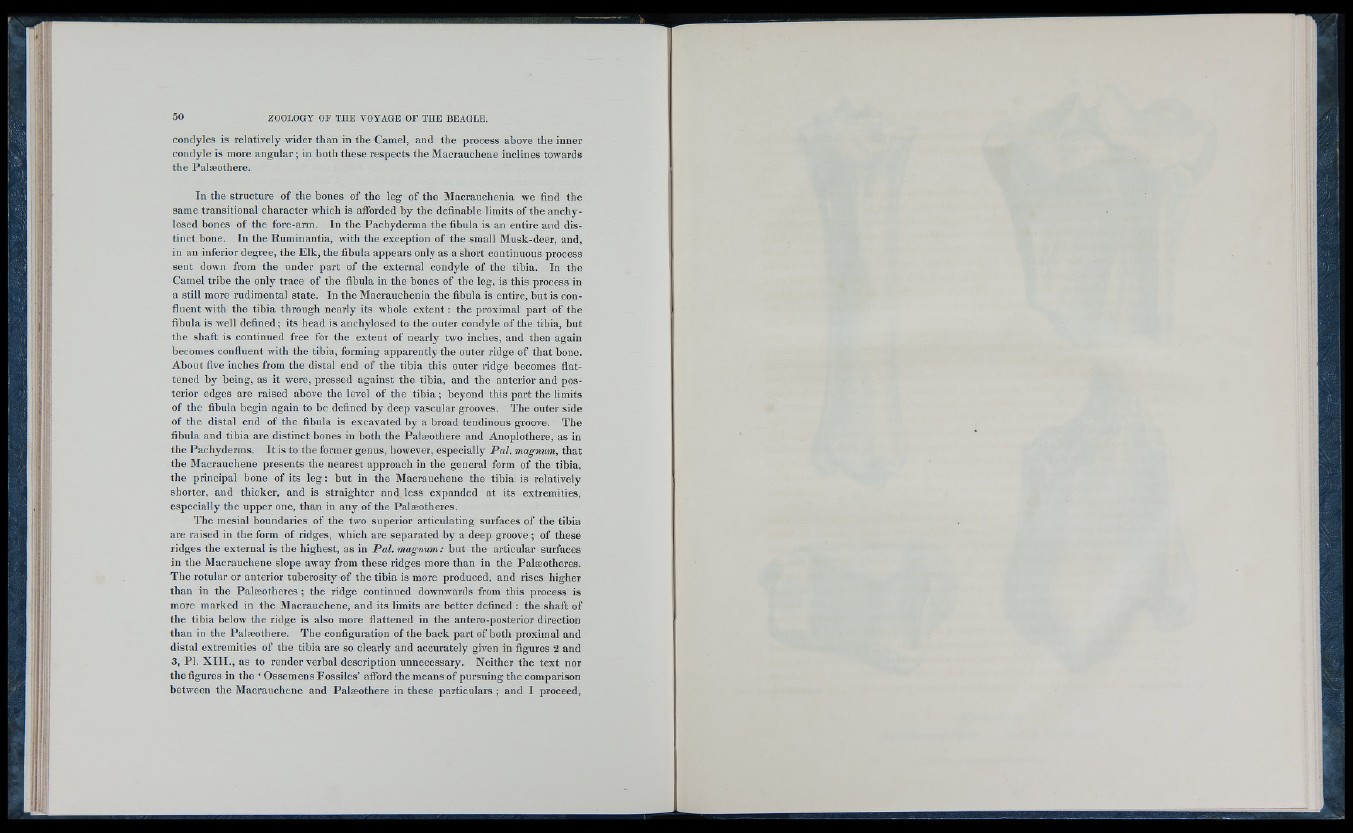
condyles is relatively wider than in the Camel, and the process above the inner
condyle is more angular ; in both these respects the Macrauchene inclines towards
the Palæothere.
In the structure o f the bones o f the le g o f the Macrauchenia we find the
same transitional character which is afforded by the definable limits o f the anchylosed
bones o f the fore-arm. In the Pachyderma the fibula is an entire and distinct
bone. In the Ruminantia, with the exception o f the small Musk-deer, and,
in an inferior degree, the E lk , the fibula appears only as a short continuous process
sent down from the under part o f the external condyle o f the tibia. In the
Camel tribe the only trace o f the fibula in the bones o f the leg, is this process in
a still more rudimental state. In the Macrauchenia the fibula is entire, but is confluent
with the tibia through nearly its whole extent : the proximal part o f the
fibula is well defined ; its head is anchylosed to the outer condyle o f the tibia, but
the shaft is continued free for the extent o f nearly two inches, and then again
becomes confluent with the tibia, forming apparently the outer ridge o f that bone.
About five inches from the distal end o f the tibia this outer ridge becomes flattened
by being, as it were, pressed against the tibia, and the anterior and p osterior
edges are raised above the level o f the tibia ; beyond this part the limits
o f the fibula begin again to be defined by deep vascular grooves. The outer side
o f the distal end of the fibula is excavated b y a broad tendinous groove. The
fibula and tibia are distinct bones in both the Palæothere and Anoplothere, as in
the Pachyderms. It is to the former genus, however, especially P a l. magnum, that
the ]Macrauchene presents the nearest approach in the general form o f the tibia,
the principal bone o f its le g : but in the Macrauchene the tibia is relatively
shorter, and thicker, and is straighter and le ss expanded at its extremities,
e sp e c ia lly the upper one, than in any o f the Palæotheres.
T he mesial boundaries o f the two superior articulating surfaces o f the tibia
are raised in the form o f ridges, which are separated by a deep groove ; o f these
ridges the external is the highest, as in P a l. magnum: but the articular surfaces
in the Macrauchene slope away from these ridges more than in the Palæotheres.
The rotular or anterior tuberosity o f the tibia is more produced, and rises higher
than in the Palæotheres ; the ridge continued downwards from this process is
more marked in the Macrauchene, and its limits are better defined : the shaft o f
the tibia below the ridge is also more flattened in the antero-posterior direction
than in the Palæothere. Th e configuration o f the back part o f both proximal and
distal extremities o f the tibia are so clearly and accurately given in figures 2 and
3, PI. X I I I ., as to render verbal description unnecessary. Neither the tex t nor
the figures in the ‘ Ossemens F o s s ile s ’ afford the means o f pursuing the comparison
between the Macrauchene and Palæothere in these particulars ; and I proceed,